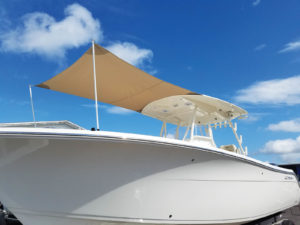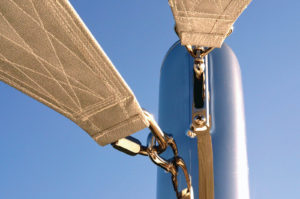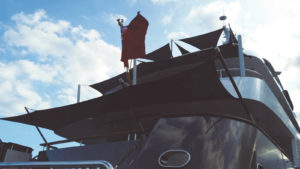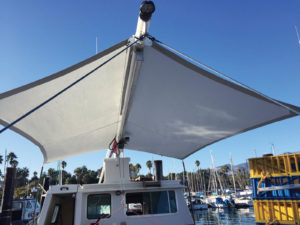
Marine fabricators help boat owners expand shading options with stretched fabric.
It could easily be argued that the pleasures of boating are best appreciated on a deck rather than in a cabin. But protection from sun exposure requires more than that provided by a wide-brimmed hat. With that kind of coverage in mind, boat owners increasingly look to tensioned-fabric shades without intrusive framework.
“The more people that see them, the more calls we get,” says Tony Shaw, owner of Affordable Canvas LLC in Venice, Fla. “We have made them for 37-foot fishing boats and 17-foot inflatables. People like the convenience and easy storage and installation of tension shades. Rods store in gunwales, and canvas folds up small enough to store anywhere.”
Kevin Stancil, owner of KTM Custom Marine Canvas in Bradenton, Fla., has noticed an increase in tension shades due to the popularity of center consoles with T-tops.
“Customers are looking for additional sun protection, which means an extension off the front and rear,” he says. “Although there are other alternatives like bimini tops, I think tension shades offer a lot more versatility. They’re easy to install and store, use existing boat features, and allow open gunnels for things like fishing and boarding.”
“There has been a huge increase in sail shades and what we call sunflys,” echoes Mike Erickson, MFC, owner of Canvas Designers® Inc. “We built our first sunfly 15-plus years ago with the concept of a quick, easy shade for the cockpit by putting a couple of poles in rod holders and tying a rectangular shade from the bridge to the poles.”

Since then, the Riviera Beach, Fla.-based company has developed two types of tension shades. One uses fixed poles with an eye for a strap cinched through a slide-bar buckle; the other uses a pulley and cam cleat on the pole for tensioning.
“We make many more sunflys now than bimini tops or cockpit covers. It really is the best system for the customer to easily put up and take down,” Erickson says.
“You achieve shade without altering what exists and with less obstructions than having a bimini frame, so you can run around the cockpit trying to reel in your fish,” notes Stephan Kåmark, owner of Advanced Canvas & Upholstery Services in Oxnard, Calif.
As owner of Wyckam Fabric Creations in Portland, Ore., Amy Poe has had more experience with larger, semi-permanent shade sails for mega yachts where the poles need to be more substantial than those that work in a standard rod holder.
“The poles and their installation can be quite expensive, since they are not just holding a load in compression but must resist leveraged tension,” she says. “As to appearance, if done correctly, they can’t be beat. Because they appear to be floating in the air, they provide an aesthetic appeal not offered by other types of shade structures.”
Katie Bradford, MFC, IFM, owner of Custom Marine Canvas in Noank, Conn., considers appearance the main selling point of tension shades.
“Often, people say, ‘I don’t want that baby-buggy look,’ which is what a bimini looks like,” she says. “There are a lot of people leaning toward shade sails because they look cool, new and edgy.”
“Biminis are a more traditional look. Sunfly or tension shades can be made modern,” agrees Kåmark.
Stancil believes that tension shades offer a superior appearance to biminis, “because the style lines flow better on the boat coming off the hardtop. It’s an extension of existing design.”

Getting crafty
Aside from appearance, the primary difference for customers between frame and tension shades is that the former is up all the time and the latter generally is not used while a boat is under way, especially at high speed.
“If customers want to run their boats with shade, biminis will work for them. If they want shade for anchoring at a sandbar or for fishing, tension shades are a much better application,” Stancil says.
“When a customer is after overhead shade and wants something that’s not permanent, we tend to go to the sunshade design,” Erickson says. “When it’s more about rain and there is not a lot of pitch or angle, we tend to move them into a framed top like a bimini.”
From the customer’s viewpoint, using a frame shade is simply a matter of walking under it. But the ease with which tension shades can be put up and taken down provides no substantial hindrance.
A difference for both consumer and fabricator lies in the hardware required.
“Conventional shade structures have either a welded, stainless steel frame or a frame made with slip fittings,” Bradford says. “They are semi-permanent, whereas tension shades are temporary, so the hardware is more in pulleys that are easily removable.”
“Sunflys require fewer parts than bimini frames,” Kåmark agrees. “The sunfly is a line to a pole and slides into a track, while biminis have zippers.”
Stancil says that determining the pole length and fabric size for a tension shade takes “a mere 10 minutes” on the craft. “We have to determine if the boat has rod holders in the gunnels. In most cases, it does,” he says. “If you don’t have the framework to attach to, you can simply add a piece of awning track to the T-top to receive the fabric.”

“Biminis require four poles that have to be bent and crowned,” he says. “There’s a lot more labor in the frame design and in cutting and sewing fabric versus a tension shade, which has two straight poles. Fabrication of a tension shade takes an hour, whereas a bimini may take six to eight hours to cut and sew. We can pass that savings on to the customer.”
But in the mega yacht realm, Poe says she contends with misconceptions about tension shade structures. “Many people expect them to be cheap since there is no elaborate frame,” she says.
Bradford acknowledges that traditional shade structures that are more permanent constitute a more complicated fabrication process that includes drilling for hardware, but states that they are, nevertheless, “pretty matter-of-fact.”
“You don’t have to worry about tension changing the shape of the fabric,” she says. “With sail shades, the correct tension between the fabric base of the sail and webbing around the perimeter is the tricky part.”
Software and hardware
Custom Marine Canvas uses WeatherMAX® and Sunbrella® Contour as well as Polyfab™ mesh fabric and webbing for tension shades.
“I usually use Sunbrella to be attached to an existing Sunbrella boat top,” Bradford says. “When it’s a large area but there’s limited storage, I use WeatherMAX because it folds up in a tighter bundle. I also use Polyfab mesh if the shade will stay out longer, because water can drain through it.”
For metal components, Bradford typically uses 1 ¼-inch-diameter stainless steel tubing, but says it can go up to a 4-inch carbon fiber tube if needed for mega yacht decks.
“The shades need to be very dimensionally stable and lightweight, so 95 percent of the time we use Serge Ferrari Stamoid® for the fabric,” Erickson says. “We have been using some new Sunbrella mesh products with good success when customers are looking for a color other than white, but those tend to be for smaller boats with smaller shades.
“The structure of the poles is critical,” he adds.
“We make our shades so the boat can run with them up. This puts a lot of tension on both the poles and the rod holders. When we started, we had some failures in this area. I cannot stress enough how important the strength of the poles and rod holders needs to be.”
Canvas Designers sourced a manufacturer to produce carbon fiber poles engineered to handle loads applied by its sunflys, which it now sells, along with a stainless steel version using a 1 ½-inch tube with a .125 wall thickness.
“Bent poles with a gimbal lock also help extend how much shade a customer gets, but this design can be tricky to execute,” Erickson says.
Advanced Canvas purchases Canvas Designers’ carbon fiber and stainless steel poles, which it uses with low-stretch mesh or solid fabric having good water repellency. “We have had good results with Stamoid, Swela, and TOP GUN®,” Kåmark says.
“There are many fabric choices suitable for sunflys.
We primarily use Sunbrella and Stamoid,” says Mark Hood, owner of Hood Canvas in Merrimac, Mass. He mostly uses 1 ¼-inch-diameter stainless awning strut poles.
KTM mostly uses Stamoid or Sunbrella fabric and aluminum for poles.
“Because tension-shade poles are straight pipe with no crown, we can use heavy-duty aluminum that is 1 ¼ inch in diameter,” Stancil says.
“We use all types of fabric: Stamoid® Light, Sur Last®, occasionally Sunbrella, but mostly [Trivantage’s] Aqualon® Edge. Lighter materials are easiest to keep taut,” Shaw says, adding that Affordable Canvas uses fiberglass poles because they provide tension with the flex of the pole itself, without the need for strapping it to the hull.
Wyckam uses stainless steel hardware with Serge Ferrari Soltis® 92 fabric for its porous nature, textured look and variety of colors.
“Tension shades are quite beautiful. And designed, installed and used correctly, they can be more economical than a structure with a full frame,” Poe says. “However, there is a lot of education required to be sure customers understand their limitations and how to properly care for them.”
Janice Kleinschmidt is a writer and magazine editor based in Palm Springs, Calif.
"We do this every day, but the beginner will have challenges in developing curvatures on the edges. There is a fine balance between effective shade and edge tension. Beginners also tend to under-engineer the poles."
Mike Erickson, Canvas Designers® Inc.
"Sailors can usually make fairly educated guesses when it comes to the size of hardware needed, but knowing exactly how much tension they will need and what
loads they will experience in use is difficult."
Amy Poe, Wyckam Fabric Creations
"The challenge is attaching hardware in an appealing design while providing support for tension load. It comes down to aesthetic and hardware locations."
Stephan Kåmark, Advanced Canvas & Upholstery Services
"Tension shades are ideal for trolling or while anchored. They are not recommended
off the front of a boat, though you can do moderate running with rear shades."
Kevin Stancil, KTM Custom Marine Canvas
"Solid tension shades cannot be left up unattended in the rain due to puddling. But the biggest limitation is the speed at which a boat can cruise with a tension shade on the bow. I have customers that say they have run about 30 knots with rear canopies up."
Tony Shaw, Affordable Canvas LLC
"The most critical thing is the proper support for a shade sail and determining
how to incorporate it on the boat, or manufacturing something custom."
Katie Bradford, Custom Marine Canvas
"Coverage on aft decks can be compromised slightly due to curves and how far aft the poles can be mounted. They can be left up for normal cruising speed in calm conditions, but common sense should prevail."
Mark Hood, Hood Canvas
 TEXTILES.ORG
TEXTILES.ORG


